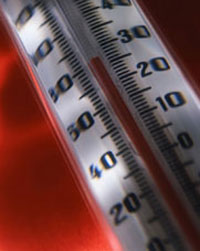全球溫度將達(dá)百萬(wàn)年來(lái)最高點(diǎn)
[ 2006-09-26 16:42 ]
|
 |
|
Earth may be close to the warmest it has been in
the last million years, especially in the part of
the Pacific Ocean where El Nino weather patterns are born, climate scientists reported
on
Monday.
|
Earth may be close to the warmest it has been in
the last million years, especially in the part of the Pacific Ocean where
El Nino weather patterns are born, climate scientists reported on Monday.
This doesn't necessarily mean there will be more
frequent El Ninos, but could well mean that these wild patterns will be
stronger when they occur, said James Hansen of NASA's Goddard Institute
for Space Studies.
The El Nino phenomenon is an important factor in monitoring global
warming, according to a paper by Hansen and colleagues published in the
current Proceedings of the National Academy of Sciences.
El Ninos can push temperatures higher than they might ordinarily be.
This happened in 1998 when a so-called "super El Nino" helped heat the
Earth to a record high.
What is significant, the scientists wrote, is that 2005 was in the same
temperature range as 1998, and probably was the warmest year ever, with no
sign of the warm surface water in the eastern equatorial Pacific typical
of an El Nino.
The waters of the western equatorial Pacific are warmer than in the
eastern equatorial Pacific, and the difference in temperature between
these two areas could produce greater temperature swings between the
normal weather pattern and El Nino, they wrote.
They blamed this phenomenon on global warming that is affecting the
surface of the western Pacific.
(Agencies) |
據(jù)氣象科學(xué)家周一介紹���,地球溫度可能將攀至百萬(wàn)年來(lái)的最高點(diǎn),尤其是在"厄爾尼諾"氣候模式產(chǎn)生的太平洋地區(qū)���。
美國(guó)國(guó)家航空航天局戈達(dá)德太空研究所的詹姆斯·漢森說(shuō):"這不一定表明'厄爾尼諾'現(xiàn)象會(huì)越來(lái)越頻繁�,但能充分說(shuō)明它會(huì)來(lái)得更猛烈�。"
漢森和他的同事在最近一期《國(guó)家科學(xué)學(xué)會(huì)學(xué)報(bào)》上發(fā)表的論文中指出,"厄爾尼諾"現(xiàn)象是監(jiān)測(cè)全球變暖的一個(gè)重要因素�����。
"厄爾尼諾"現(xiàn)象會(huì)使地球溫度升高,1998年發(fā)生的"超級(jí)厄爾尼諾"事件曾使全球溫度創(chuàng)下歷史最高紀(jì)錄�����。
論文中提到�,重要的一點(diǎn)是���,2005年的全球溫度范圍和1998年相同�,可能是近百萬(wàn)年來(lái)地球溫度最高的一年���,但常發(fā)生"厄爾尼諾"現(xiàn)象的東赤道太平洋海域的海表水溫并沒有變暖的跡象�����。
西赤道太平洋的海表溫度高于東赤道太平洋��,這兩個(gè)地區(qū)的溫度差會(huì)加大地球溫度在正常模式和"厄爾尼諾"之間的變化�。
科學(xué)家們稱���,造成這一現(xiàn)象的重要原因是全球變暖����,目前,西太平洋海域正受到全球變暖的影響��。
(英語(yǔ)點(diǎn)津姍姍編輯) |
|
|
|